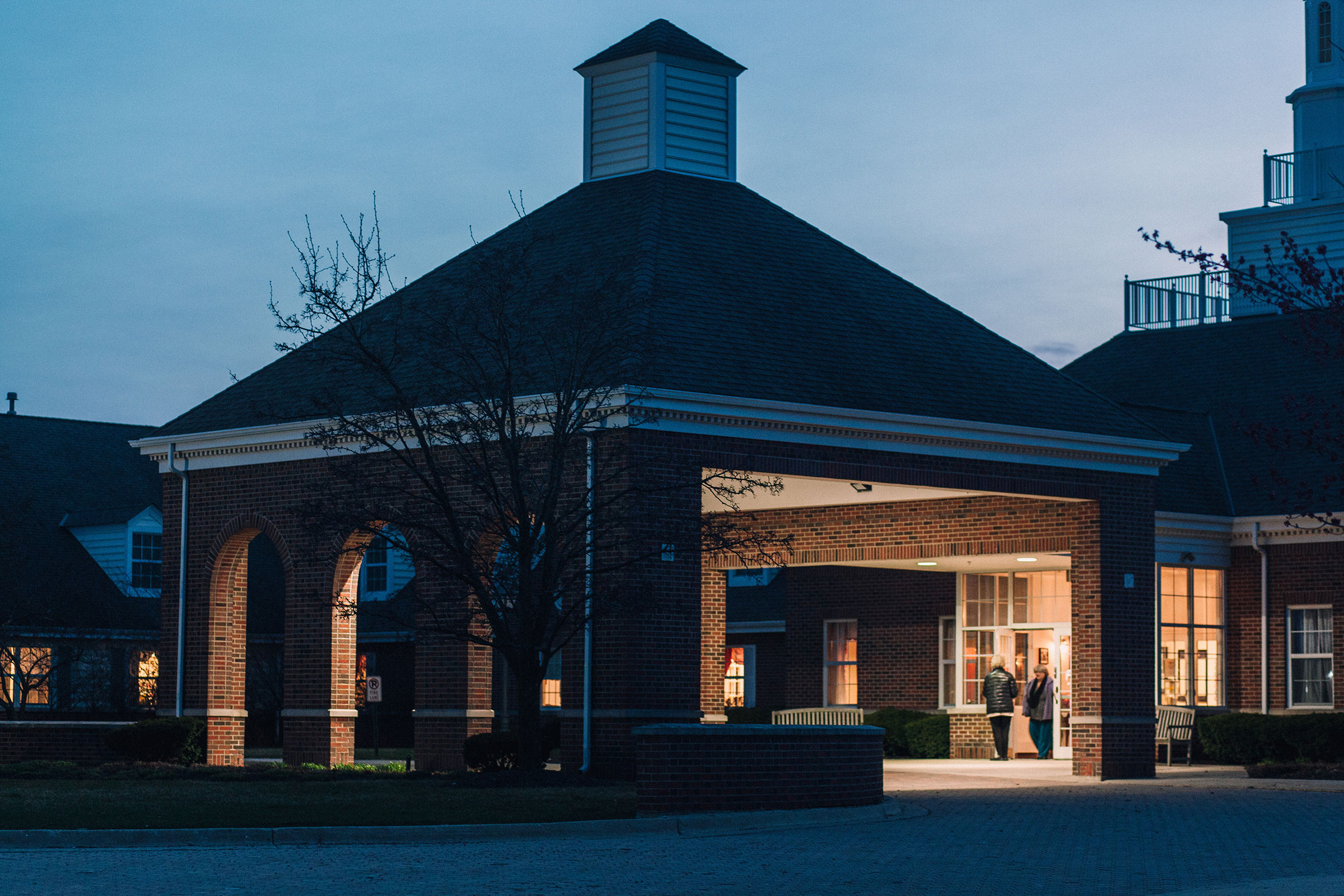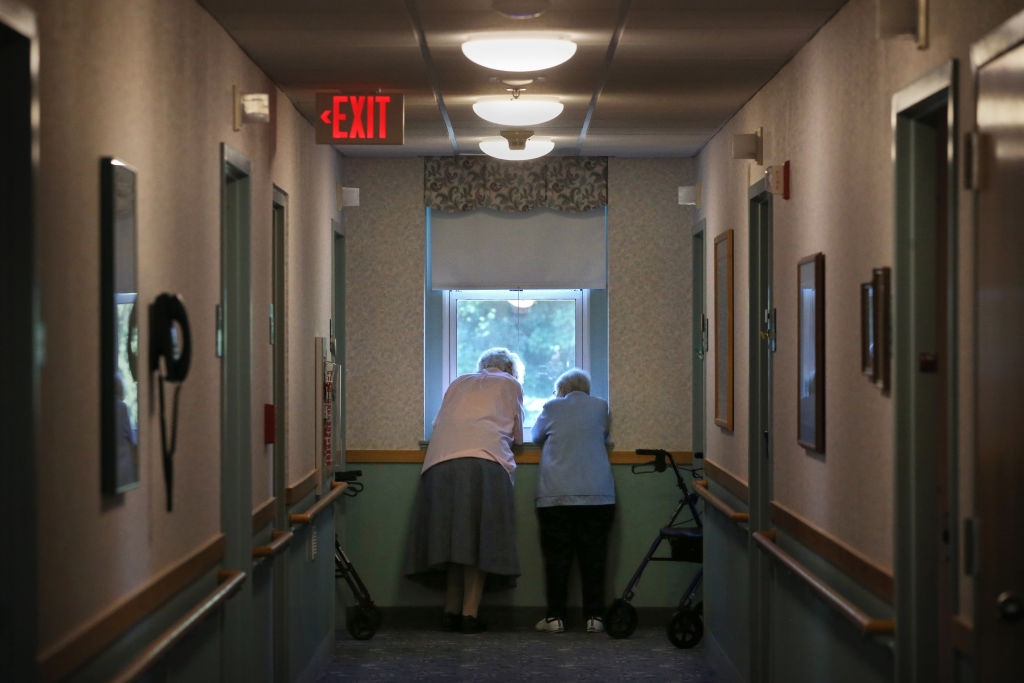
Ivan Lakos was born in Hungary and came to the United States in 1951 as a displaced person after World War II. He became a citizen after about five years and has voted consistently ever since. But this year, with COVID-19 cases again on the rise in the U.S., the 96-year-old worried whether he’d be able to continue that tradition.
Lakos lives in a skilled nursing home at the Carol Woods Retirement Community in North Carolina, which is home to roughly 500 residents and usually hosts its own polling place with volunteers on hand to help residents fill out ballots and navigate voting machines. But this year, that isn’t an option for him. To protect against COVID-19, the facility has restricted its activities and is currently banning visitors inside the buildings. For Lakos—and roughly 2.2 million other people like him who live in nursing homes and other long-term care facilities across the country—that presents a significant barrier to enfranchisement.
“We’re really concerned about folks who are in nursing homes and residential facilities,” says Michelle Bishop, voting rights specialist at the National Disability Rights Network. “A lot of the ways that we relied on getting the ballot to people who lived in nursing homes and long-term care facilities have been eliminated by the pandemic.”
While many Americans have turned to absentee and mail-in ballots this year, those methods are not an easy solution for many elderly. “My hands don’t work too well,” says Lakos, considering the possibility of mailing in his ballot. “The pen doesn’t go where I want it to go.” Under a North Carolina law, nursing home staff are not allowed to help residents fill out ballots, and many residents, including Lakos, have no surviving family members nearby who can lend a hand. (Before COVID-19, many North Carolina counties sent teams to nursing homes and other care facilities to help residents cast ballots. But this year, visitor restrictions limited those efforts, too.)
The stakes are particularly high this year because older Americans represented a key voting bloc for Donald Trump in 2016, but recent polls suggest they may be switching sides. Former Vice President Joe Biden now leads Trump among Americans age 65 and over by 21 points in a new CNN poll, by 27 points in an NBC/WSJ poll, and by an even larger margin in a Newsy/YouGov poll of moderate voters in battleground states. Trump himself seems aware of the dangers of this “gray revolt.” On Thursday, he tweeted a video aimed at older voters with the message “TO MY FAVORITE PEOPLE IN THE WORLD!”
But the Trump Administration’s lackluster response to the coronavirus pandemic appears to have resonated among the older population. Most people in residential care facilities are elderly or have disabilities, making them high risk of getting severely ill from the coronavirus. And the pandemic has already hit them hard: at least 40% of all deaths from COVID-19 in the U.S. have been linked to long-term care facilities. Even seven months into the pandemic, these facilities are still struggling to maintain adequate personal protective equipment (PPE), staffing levels and coronavirus testing to keep everyone safe. Now, visitor restrictions put in place to keep the virus out, combined with pandemic-driven changes to state voting rules and U.S. Postal Service delays have created a perfect storm of obstacles that could mean the disenfranchisement of a vast segment of America’s older and disabled voters.
While there’s very little data about voter participation among nursing home residents, older voters more broadly are among the most politically engaged. In 2016, turnout among those aged 65 and over was 70.9% compared to 46.1% among 18 to 29 year olds, and in 2018, it was 66.1% compared to 35.6% for the younger group.
Trump’s repeated discrediting of mail-in voting and suggesting without evidence that it’s more susceptible than other forms of voting to widespread fraud, has left voting advocates, long-term care facilities and elections officials scrambling to ensure people like Lakos have access to the ballot box. Nursing homes and other facilities that receive Medicare or Medicaid funds are obligated by federal law to support residents’ rights, which include voting. The Centers for Medicare and Medicaid Services (CMS), which oversees long-term care facilities, put out new guidance this week reminding institutions of this requirement. But institutions are rarely penalized for failing to fulfill that duty, says Nina Kohn, a law professor at Syracuse University who specializes in elder law.
LeadingAge, an organization representing nonprofit nursing homes and other aging service providers, recently published a voting toolkit for its members and asked a representative from the National Association of Secretaries of State to offer advice during its regular call for providers this week. “This is a demographic that has voted in large numbers in the past and really values their right to vote,” says LeadingAge president and CEO Katie Smith Sloan. “Our members know that, and they’re going to do everything to make it possible for them to do that.”

‘All Lights Are Blinking Red’
In normal times, many long-term care facilities including Carol Woods Retirement Community, serve as official polling sites. Staff organize group outings to vote on Election Day or those who vote absentee by mail can get help from friends and family members. This year, many states followed Centers for Disease Control and Prevention guidelines and moved polling places out of care facilities. Residents in states like Texas and Pennsylvania have been warned they may need to quarantine or may have trouble getting back into nursing homes if they leave to vote in person.
For those that are voting absentee—an option that has made voting much easier for many Americans this year—election officials have been racing to come up with new nursing home voting procedures to match their counties’ changing situations.
Wisconsin canceled its usual effort to send election officials into nursing homes to assist with voting. States like North Carolina, Florida and Ohio have left it up to local jurisdictions to figure out procedures for sending teams to individual facilities. Iowa typically sends bipartisan teams of election officials to deliver ballots to nursing facilities, but switched to mailing ballots to those voters amid the pandemic. All of these plans rely on the assistance of workers in long-term care facilities, which are already understaffed and stretched thin as they fight ongoing COVID-19 outbreaks.
“From a staffing perspective, I’ve been saying for a couple weeks right now, all lights are blinking red. It’s a catastrophic situation,” says Sondra Norder, president and CEO of the St. Paul Elder Services nursing home and assisted living facilities in Kaukauna and Green Bay, Wisconsin. Norder has been able to have her team of social workers help residents with their absentee ballots so the work doesn’t fall on nursing staff, but she notes a smaller institution with fewer social workers might not have that option.
In Louisiana and North Carolina, where Lakos lives, state laws prevent residential care facility workers from helping with ballots at all. Kohn at Syracuse says this goes against the Voting Rights Act, but when a North Carolina resident sued the state over the issue this summer, a federal court found only that voter’s rights had been violated and that the ban on assistance could continue.
Even in places where staff can assist, plenty of challenges remain. Many nursing home residents have some level of memory loss or mental impairment, and while this does not mean they lose their right to vote, it may cause staff to make arbitrary judgments about who gets to vote. Some states also bar facility staff from answering questions about candidates’ platforms to avoid influencing residents, and others require an official witness in an attempt to target voter fraud that largely does not exist.
“When states create procedural barriers to voting, many people aren’t able to comply. And nursing home residents and long term care residents more broadly, are populations of people who are often not going to be able to clear those hurdles,” says Kohn. “It really is a perfect storm for disenfranchising nursing home residents.”
An Ad-Hoc Solution
Fortunately, for Lakos, a solution recently reemerged. Sindy Barker, a former judge and a resident in the independent living portion of Carol Woods, organized a group of her fellow residents to provide voting information, serve as witnesses for people voting by mail, and aid those who needed help filling out their ballots. Last week, Barker sat across a large table from Lakos in the open air outside his building to help him fill out his ballot.
“I probably wouldn’t have been able to vote unless Sindy had developed that way,” Lakos says.
Barker is still working hard to get 100% of the residents who can vote at Carol Woods to do so before Oct. 15 so she can know their ballots will be counted on Election Day. There will still be an in-person voting site for some residents, but she’s encouraging those who can to vote now to cut down on lines and crowding. She’s been spending about four hours a day, multiple days each week, reaching out to fellow residents, contacting their families, reading out ballots and serving as a witness herself.
She also serves on the legislative committee for the North Carolina Continuing Care Residents Association, and says she is encouraging other retirement communities to develop similar programs to her homegrown effort. But if they don’t have someone like her to volunteer the time and facilities can’t let election officials in, she’s not sure what will happen.
“I am worried about them,” Barker says of other long-term care facilities in North Carolina. “But I can simply encourage them. This is really important.”
More Must-Reads from TIME
- Introducing the 2024 TIME100 Next
- The Reinvention of J.D. Vance
- How to Survive Election Season Without Losing Your Mind
- Welcome to the Golden Age of Scams
- Did the Pandemic Break Our Brains?
- The Many Lives of Jack Antonoff
- 33 True Crime Documentaries That Shaped the Genre
- Why Gut Health Issues Are More Common in Women
Write to Abigail Abrams at abigail.abrams@time.com
